Experimental and Numerical Fracture Characterization of DP1180 Steel in Combined Simple Shear and Uniaxial Tension
Abstract
1. Introduction
2. Plasticity Characterization
2.1. Anisotropic Yield Criterion
2.2. Hardening Behavior
2.3. Fracture Modelling
2.3.1. Strain State and Stress State Characterization
2.3.2. Damage Accumulation
2.3.3. Calibration of the Fracture Locus of DP1180
3. Fracture Characterization of Combined Shear–Tensile Loading Condition
3.1. Geometry Selection
3.2. Finite Element Analysis
3.2.1. Details of Finite Element Simulation
3.2.2. Results of Finite Element Simulation
3.3. Experimental Evaluation
3.3.1. Procedure
3.3.2. Comparative Study of Experimental and Numerical Data
3.3.3. Location of Fracture Initiation
4. Recalibration of the Fracture Locus
5. Conclusions
- The SA + 1 geometry, based on the model by Shouler and Allwood [23], exhibited an average triaxiality value of approximately 0.15. There was a high likelihood of fracture initiation at the edge of the specimen. Consequently, the SA + 1 geometry provided a conservative estimate of the fracture strain in combined uniaxial tension and shear.
- The MS–ZO geometry, a modified mini–shear geometry inspired by Peirs et al. [52], maintained a triaxiality value of approximately 0.20. Significant void damage was observed within the center of the gauge region during the DP1180 steel tests. In addition, the MS–ZO geometry demonstrated a more constant stress–state compared to the SA + 1. The simple MS–ZO with a single gauge region appears attractive for combined shear and tensile fracture characterization of materials with similar ductility to DP1180.
- The MMC fracture locus was initially calibrated based on four data points obtained from characterization tests in which necking was suppressed. The MMC fracture locus closely predicted the observed behavior between shear and uniaxial tension. This was not expected, given the phenomenological nature of the MMC model and that no data for combined shear and tension was used in its calibration. The inclusion of the fracture strain at the intermediate triaxiality of 0.20 from the MS–ZO test was crucial to confirm the predicted MMC fracture locus for DP1180. The addition of five test points allowed for the use of a five–parameter version of the MMC model with a markedly improved calibration from shear to biaxial tension.
- It is recommended that future studies include combined tension and shear tests such as the MS–ZO to evaluate the predictive accuracy of the MMC model. For the DP1180, the MMC model accurately predicted the fracture strain of the MS–ZO, but it remains unclear if this would hold for other AHSS.
- For the DIC and finite-element lengthscales considered in this work, there does appear to be a valley or trough in the fracture strain of DP1180 sheet in a combined loading of simple shear with a superimposed uniaxial tension. It is possible that the trend could be different in other loading scenarios with the same nominal triaxiality and Lode parameters, such as in simple shear with a superimposed plane strain tension in tension–torsion tests of tubes, as discussed in Butcher and Abedini [22].
Author Contributions
Funding
Data Availability Statement
Acknowledgments
Conflicts of Interest
Appendix A
Appendix A.1. Investigation of Combined Geometries
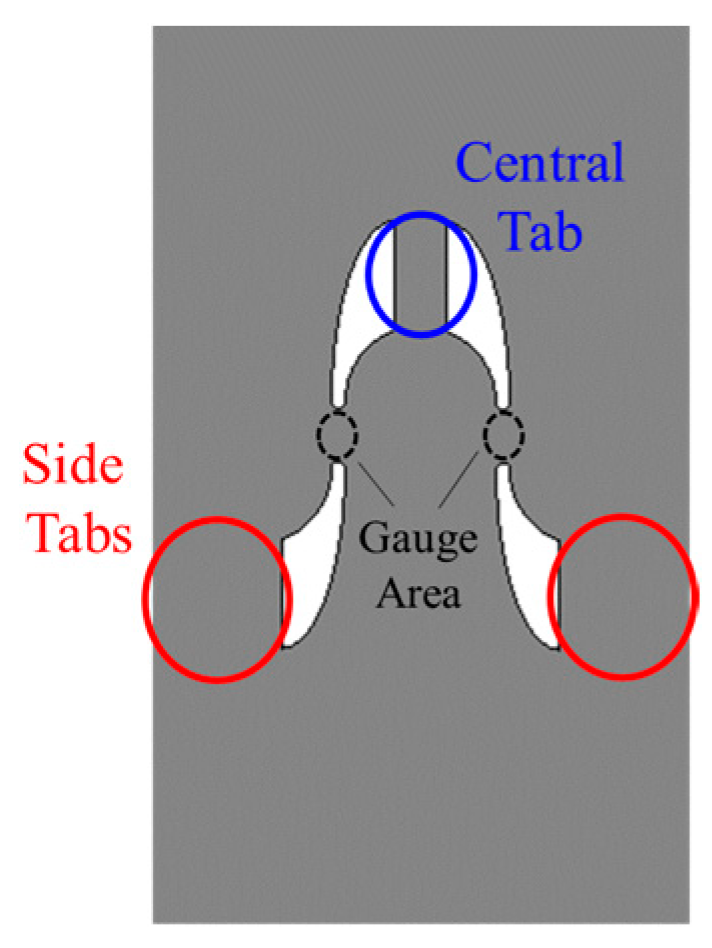
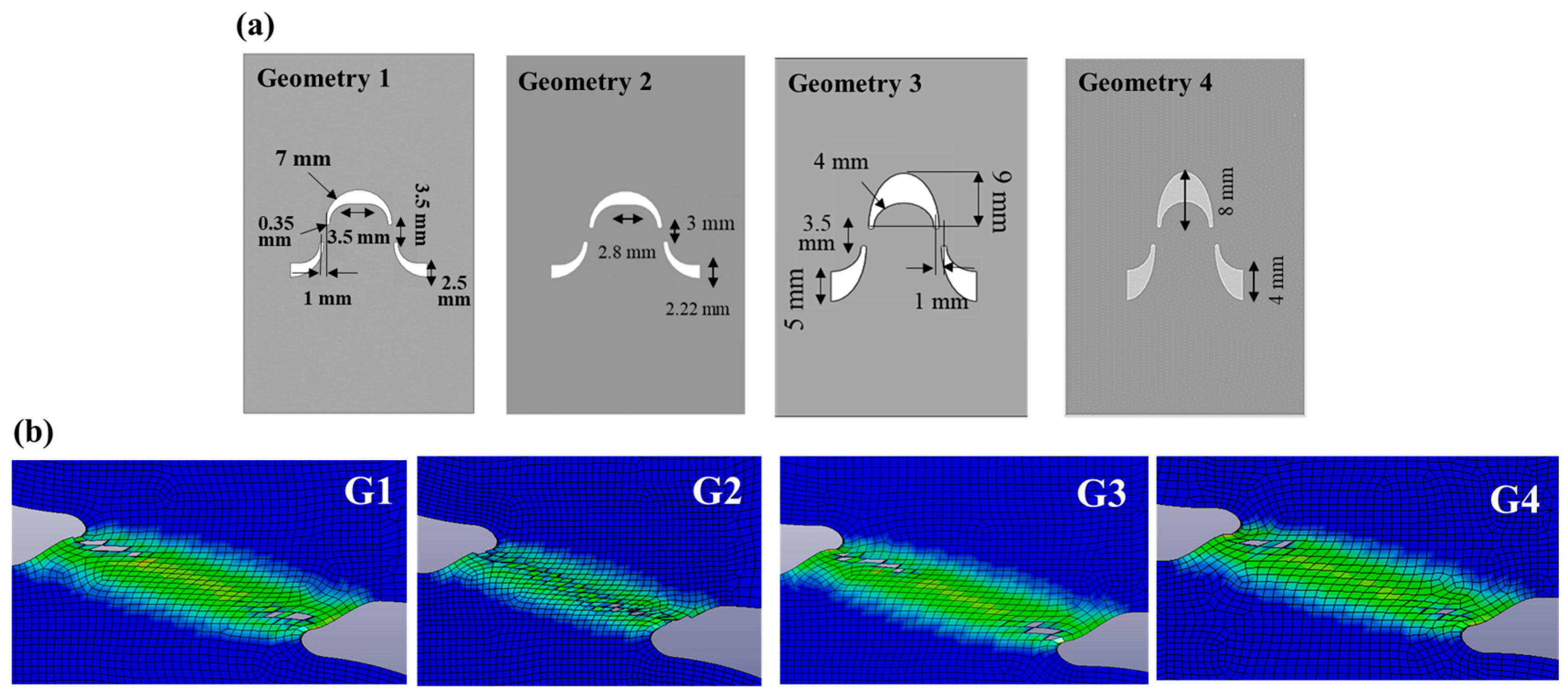
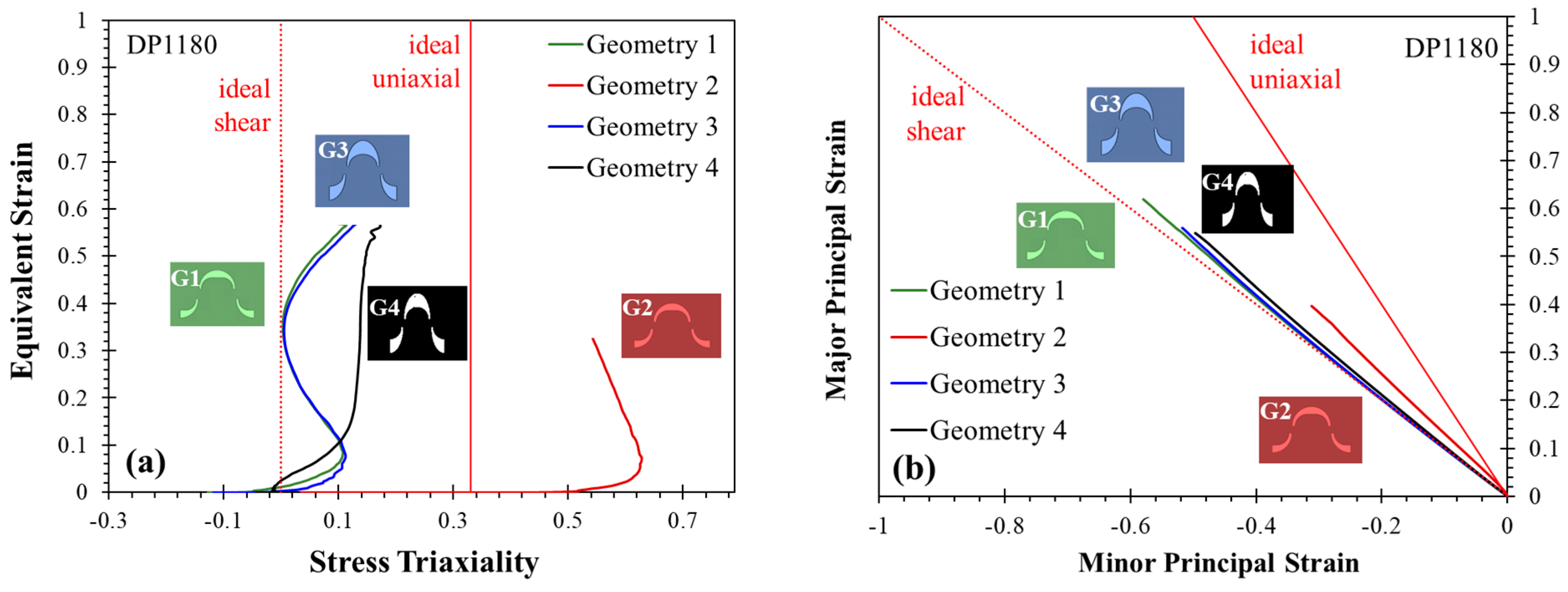
Appendix A.2. Evaluation of Mesh Size Convergence
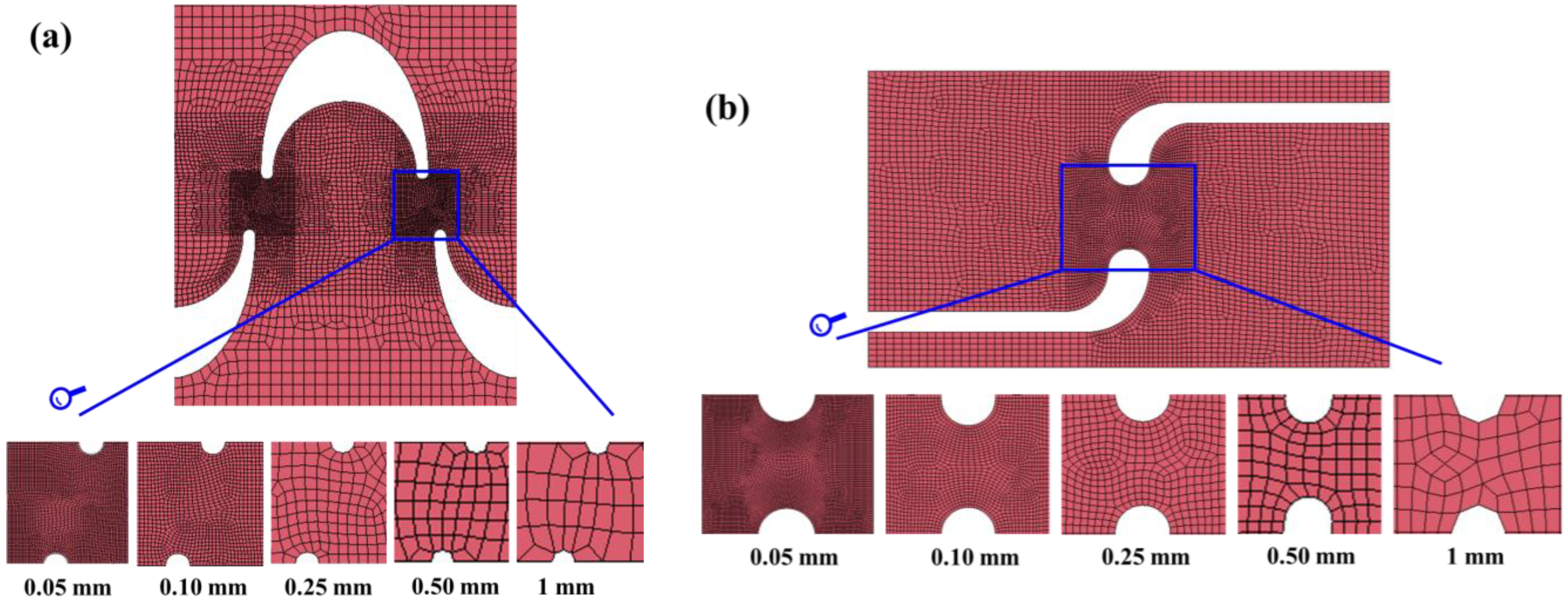
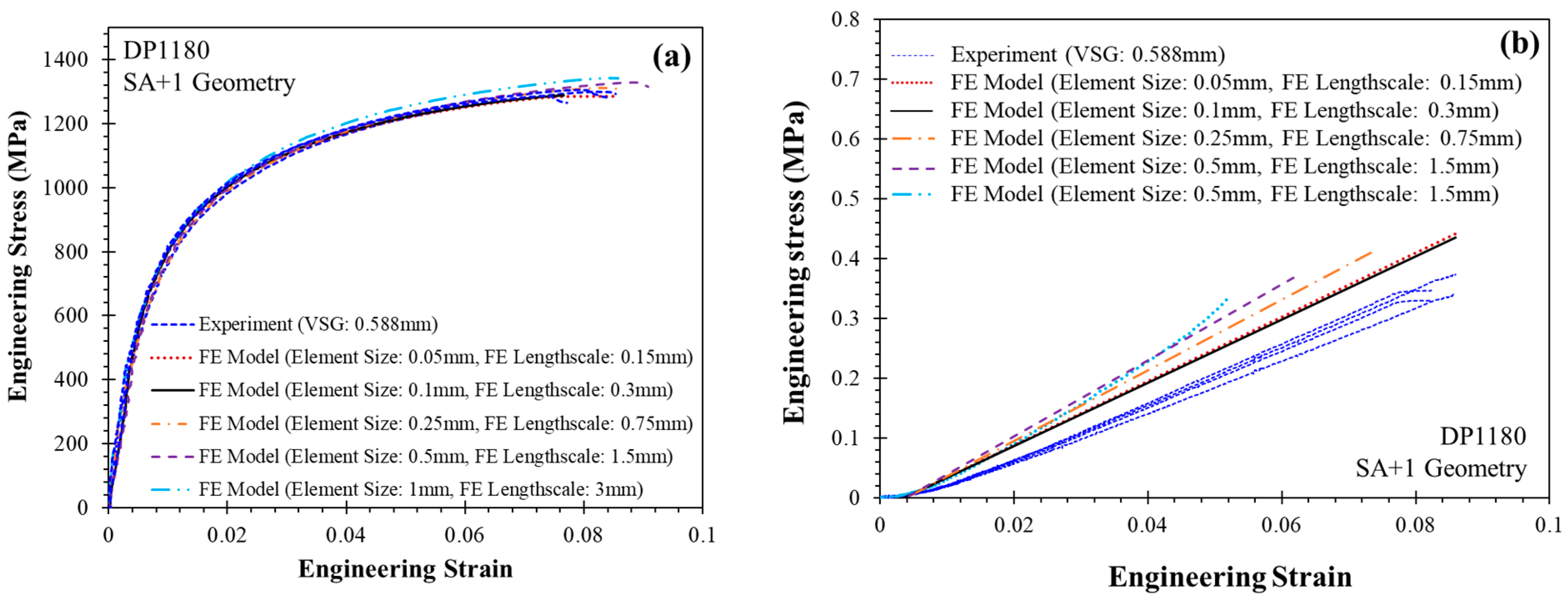
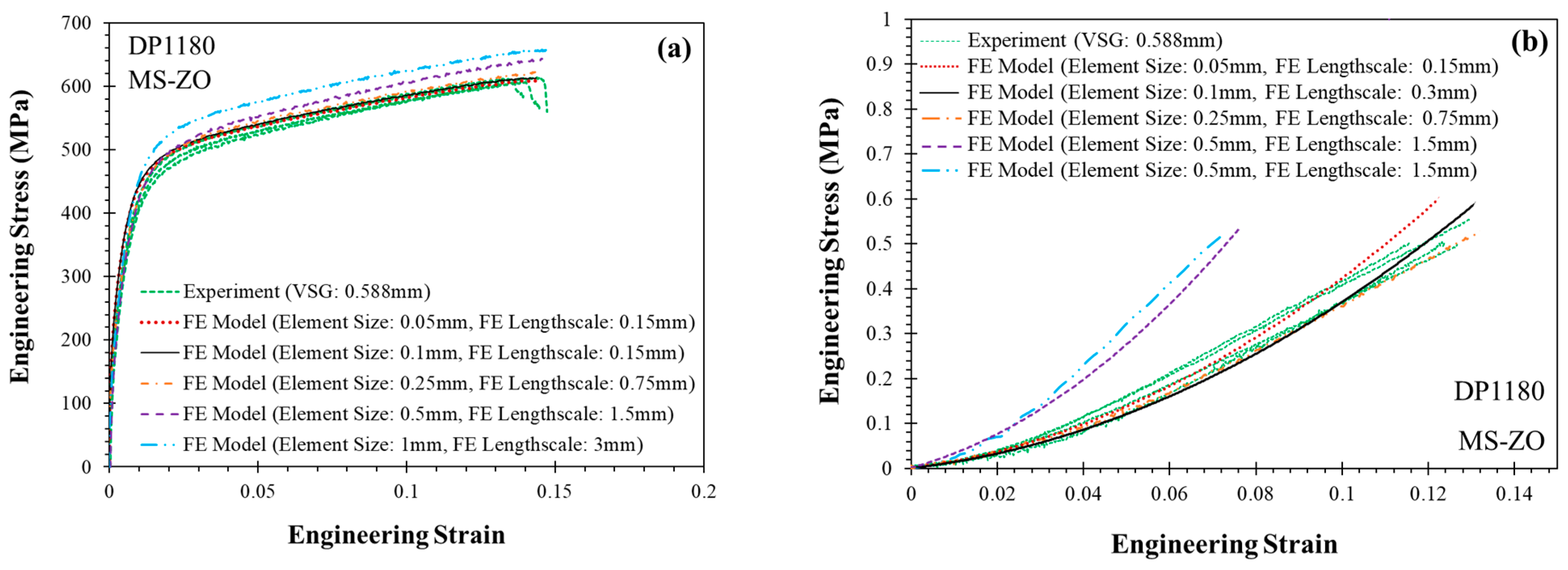
References
- Bai, Y.; Wierzbicki, T. Application of extended Mohr–Coulomb criterion to ductile fracture. Int. J. Fract. 2010, 161, 1–20. [Google Scholar] [CrossRef]
- Rahmaan, T.; Butcher, C.; Kim, S.; Worswick, M. Characterization and prediction of fracture in 6000– and 7000–series aluminum alloy sheet under various stress states. Thin–Walled Struct. 2022, 173, 108958. [Google Scholar] [CrossRef]
- Wei, X.; Liu, Y.; Zhang, X. Effect of non–linear tension–compression loading reversal on the hardening behavior and initiation fracture strain of a cold–rolled TRIP780 steel sheet. Mater. Today Commun. 2022, 30, 103076. [Google Scholar] [CrossRef]
- Lim, S.; Huh, H. Ductile fracture behavior of BCC and FCC metals at a wide range of strain rates. Int. J. Impact Eng. 2022, 159, 104050. [Google Scholar] [CrossRef]
- Chandran, S.; Liu, W.; Lian, J.; Munstermann, S.; Verleysen, P. Strain rate dependent plasticity and fracture of DP1000 steel under proportional and non–proportional loading. Eur. J. Mech. A/Solids 2022, 92, 104446. [Google Scholar] [CrossRef]
- Pathak, N.; Butcher, C.; Worswick, M.J.; Bellhouse, E.; Gao, J. Damage evolution in complex–phase and dual–phase steels during edge stretching. Materials 2017, 10, 346. [Google Scholar] [CrossRef]
- Erice, B.; Roth, C.C.; Mohr, D. Stress–state and strain–rate dependent ductile fracture of dual and complex phase steel. Mech. Mater. 2018, 116, 11–32. [Google Scholar] [CrossRef]
- Narayanan, A.; Abedini, A.; Khameneh, F.; Butcher, C. An Experimental Methodology to Characterize the Uniaxial Fracture Strain of Sheet Metals Using the Conical Hole Expansion Test. J. Mater. Eng. Perform. 2022, 32, 4456–4482. [Google Scholar] [CrossRef]
- Noder, J.; Gutierrez, J.; Zhumagulov, A.; Khameneh, F. Constitutive, Formability, and Fracture Characterization of 3rd Gen AHSS with an Ultimate Tensile Strength of 1180 MPa. SAE Tech. 2021, 3, 1395–1407. [Google Scholar] [CrossRef]
- Beerli, T.; Grolleau, V.; Mohr, D.; Roth, C.C. Axisymmetric V–Bending of Sheet Metal: Determining the Fracture Strain and the Weakest Material Direction for Plane Strain Tension in One Test. IOP Conf. Ser. Mater. Sci. Eng. 2022, 1238, 012052. [Google Scholar] [CrossRef]
- Roth, C.C.; Mohr, D. Ductile fracture experiments with locally proportional loading histories. Int. J. Plast. 2016, 79, 328–354. [Google Scholar] [CrossRef]
- Grolleau, V.; Roth, C.C.; Mohr, D. Characterizing plasticity and fracture of sheet metal through a novel in–plane torsion experiment. IOP Conf. Ser. Mater. Sci. Eng. 2019, 651, 012101. [Google Scholar] [CrossRef]
- Narayanan, A.; Abedini, A.; Weinschenk, A.; Worswick, M.; Butcher, C. Evaluation of Simple Shear Test Geometries for Constitutive Characterization using Virtual Experiments. IOP Conf. Ser. Mater. Sci. Eng. 2021, 1157, 012066. [Google Scholar] [CrossRef]
- Roth, C.C.; Mohr, D. Determining the strain to fracture for simple shear for a wide range of sheet metals. Int. J. Mech. Sci. 2018, 149, 224–240. [Google Scholar] [CrossRef]
- Traphöner, H.; Clausmeyer, T.; Tekkaya, A.E. Methods for measuring large shear strains in in–plane torsion tests. J. Mater. Process. Technol. 2021, 287, 116516. [Google Scholar] [CrossRef]
- Wei, S.; Kim, J.; Tasan, C. In–situ investigation of plasticity in a TI–Al–V–Fe (α+β) alloy: Slip mechanisms, strain localization, and partitioning. Int. J. Plast. 2022, 148, 103131. [Google Scholar] [CrossRef]
- Wu, H.; Huang, M.; Xia, Y.; Li, X.; Li, R.; Liu, C.; Gan, W.; Xiao, T.; Geng, L.; Liu, Q.; et al. The importance of interfacial stress–affected zone in evading the strength–ductility trade–off of heterogeneous multi–layered composites. Int. J. Plast. 2023, 160, 103485. [Google Scholar] [CrossRef]
- Weinder, A.; Biermann, H. Review on Strain Localization Phenomena Studied by High–resolution digital image correlation. Adv. Eng. Mater. 2021, 23, 2001409. [Google Scholar]
- Tang, A.; Liu, H.; Liu, G.; Zhong, Y.; Wang, L.; Lu, Q.; Wang, J.; Shen, Y. Normal distribution of local strain: A universal law of plastic deformation in material. Phy. Rev. Lett. 2020, 124, 155501. [Google Scholar] [CrossRef]
- Tvergaard, V. Effect of stress–state and spacing on voids in a shear–field. Int. J. Solids Struct. 2012, 49, 3047–3054. [Google Scholar] [CrossRef]
- Tvergaard, V. Behaviour of porous ductile solids at low stress triaxiality in differentmodes of deformation. Int. J. Solids Struct. 2015, 60–61, 28–34. [Google Scholar] [CrossRef]
- Butcher, C.; Abedini, A. On Phenomenological Failure Loci of Metals under Constant Stress States of Combined Tension and Shear. Metals 2019, 9, 1052. [Google Scholar] [CrossRef]
- Shouler, D.R.; Allwood, J.M. Design and use of a novel sample design for formability testing in pure shear. J. Mater. Process. Technol. 2010, 210, 1304–1313. [Google Scholar] [CrossRef]
- Jawale, K.; Duarte, J.F.; Reis, A.; Silva, M.B. Characterizing fracture forming limit and shear fracture forming limit for sheet metals. J. Mater. Process. Technol. 2018, 255, 886–897. [Google Scholar] [CrossRef]
- Scales, M.; Tardif, N.; Kyriakides, S. Ductile failure of aluminum alloy tubes under combined torsion and tension. Int. J. Solids Struct. 2016, 97–98, 116–128. [Google Scholar] [CrossRef]
- Scales, M.; Chen, K.; Kyriakides, S. Material response, localization, and failure of an aluminum alloy under combined shear and tension: Part i experiments. Int. J. Plast. 2019, 120, 340–360. [Google Scholar] [CrossRef]
- Ferreira, I.; Jesus, A.; Machado, M.; Pereira, J.; Alves, J.L.; Xavier, J. Experimental characterisation of fused filament fabrication printed parts under tension, shear, and combined shear–tension loads via Arcan test. Proc. Inst. Mech. Eng. Part L J. Mater. Des. Appl. 2020, 234, 835–850. [Google Scholar] [CrossRef]
- Kumar, A.; Singha, M.K.; Tiwari, V. Structural response of metal sheets under combined shear and tension. Structures 2020, 26, 915–933. [Google Scholar] [CrossRef]
- Mohr, D.; Henn, S. Calibration of stress–triaxiality dependent crack formation criteria: A new hybrid experimental–numerical method. Exp. Mech. 2007, 47, 805–820. [Google Scholar] [CrossRef]
- Dunand, M.; Mohr, D. Optimized butterfly specimen for the fracture testing of sheet materials under combined normal and shear loading. Eng. Fract. Mech. 2011, 78, 2919–2934. [Google Scholar] [CrossRef]
- Butcher, C.; Abedini, A. Shear confusion_ Identification of the appropriate equivalent strain in simple shear using the logarithmic strain measure. Int. J. Mech. Sci. 2017, 134, 273–283. [Google Scholar] [CrossRef]
- Peirs, J.; Verleysen, P.; Van Paepegem, W.; Degrieck, J. Determining the stress–strain behaviour at large strains from high strain rate tensile and shear experiments. Int. J. Impact Eng. 2011, 38, 406–415. [Google Scholar] [CrossRef]
- Noder, J.; Gutierrez, J.; Abedini, A.; Zhumagulov, A.; Dykeman, J.; Ezzat, H.; Butcher, C. A comparative evaluation of third–generation advanced high–strength steels for automotive forming and crash applications. Materials 2021, 14, 4970. [Google Scholar] [CrossRef]
- Samadian, P.; O’keeffe, C.; Butcher, C.; Worswick, M. Fracture Response in Hot–Stamped Tailor–Welded Blanks of Ductibor® 500-AS and Usibor® 1500-AS: Experiments and Modelling. Eng. Fract. Mech. 2021, 253, 107864. [Google Scholar] [CrossRef]
- Renault, C.; Churyumov, A.; Pozdniakov, A. Microstructure and hot deformation behavior of FeMnAlCMo steel. J. Mater. Res. Technol. 2020, 9, 4440–4449. [Google Scholar] [CrossRef]
- Shaikh, A.; Churyumov, A.; Pozdniakov, A.; Churyumova, T. Simulation of the hot deformation and fracture behavior of reduced activation ferritic/martensitic 13CrMoNbV Steel. Appl. Sci. 2020, 10, 530. [Google Scholar] [CrossRef]
- Abedini, A.; Noder, J.; Kohar, C.P.; Butcher, C. Accounting for Shear Anisotropy and Material Frame Rotation on the Constitutive Characterization of Automotive Alloys using Simple Shear Tests. Mech. Mater. 2020, 148, 103419. [Google Scholar] [CrossRef]
- Fast–Irvine, C.; Abedini, A.; Noder, J.; Butcher, C. An Experimental Methodology to Characterize the Plasticity of Sheet Metals from Uniaxial to Plane Strain Tension. Exp. Mech. 2021, 61, 1381–1404. [Google Scholar] [CrossRef]
- Khameneh, F.; Abedini, A.; Butcher, C. Lengthscale effects in optical strain measurement for fracture characterization in simple shear. Int. J. Fract. 2021, 232, 153–180. [Google Scholar] [CrossRef]
- Butcher, C.; Khameneh, F.; Abedini, A.; Connolly, D.; Kurukuri, S. On the experimental characterization of sheet metal formability and the consistent calibration of the MK model for biaxial stretching in plane stress. J. Mater. Process. Technol. 2021, 287, 116887. [Google Scholar] [CrossRef]
- Abedini, A.; Narayanan, A.; Butcher, C. An Investigation into the Characterization of the Hardening Response of Sheet Metals using Tensile and Shear Tests with Surface Strain Measurement. Forces Mech. 2022, 7, 100090. [Google Scholar] [CrossRef]
- Numisheet, The 12th International Conference and Workshop on Numerical Simulation of 3D Sheet Metal Forming Processes, Toronto, ON, Canada, 10–14 July 2022. Available online: https://www.tms.org/portal/Meetings___Events/2021/NUMISHEET2021/default.aspx (accessed on 10 July 2022).
- Barlat, F.; Aretz, H.; Yoon, J.W.; Karabin, M.E.; Brem, J.C.; Dick, R.E. Linear transformation–based anisotropic yield functions. Int. J. Plast. 2005, 21, 1009–1039. [Google Scholar] [CrossRef]
- Fast–Irvine, J.C. Experimental Methods for the Constitutive Characterization of Sheet Materials in Generalized Plane Strain. Master’s Thesis, University of Waterloo, Waterloo, ON, Canada, 2022. [Google Scholar]
- Heibel, S.; Dettinger, T.; Nester, W.; Clausmeyer, T.; Tekkaya, A.E. Damage mechanisms and mechanical properties of high–strength multiphase steels. Materials 2018, 11, 761. [Google Scholar] [CrossRef] [PubMed]
- Bai, Y.; Wierzbicki, T. A new model of metal plasticity and fracture with pressure and Lode dependence. Int. J. Plast. 2008, 24, 1071–1096. [Google Scholar] [CrossRef]
- Neukamm, F.; Feucht, M.; Haufe, A.; Roll, K. A Generalized incremental stress state dependent damage model for forming and crashworthiness simulations. In Proceedings of the Numisheet: 7th International Conference and Workshop on Numerical Simulation of 3D Sheet Metal Forming Processes, Interlaken, Switzerland, 1–5 September 2008. [Google Scholar]
- Johnson, G.R.; Cook, W.H. Fracture characteristics of three metals subjected to various strains, strain rates, temperatures and pressures. Eng. Fract. Mech. 1985, 21, 31–48. [Google Scholar] [CrossRef]
- Coulomb, C. Essai sur une application des regles des maximis et minimis a quelues problemes de statique relatifs a l’architecture. Mem. Acad. Roy. Des Sci. 1773, 7, 343–382. [Google Scholar]
- Mohr, O. Abhandlungen Aus Dem Gebiete Der Technischen Mechanik, 2nd ed.; Forgotten Books: Berlin, Germany, 1914. [Google Scholar]
- Korkolis, Y.; Kyriakides, S. Inflation and burst of aluminum tubes. Part II: An advanced yield function including deformation–induced anisotropy. Int. J. Plast. 2008, 24, 1625–1637. [Google Scholar] [CrossRef]
- Peirs, J.; Verleysen, P.; Degrieck, J. Novel Technique for Static and Dynamic Shear Testing of Ti6Al4V Sheet. Exp. Mech. 2012, 52, 729–741. [Google Scholar] [CrossRef]
- Puso, M.A. A highly efficient enhanced assumed strain physically stabilized hexahedral element. Int. J. Numer. Methods Eng. 2000, 49, 1029–1064. [Google Scholar] [CrossRef]
- Jones, E.M.C.; Iadicola, M.A. A Good Practices Guide for Digital Image Correlation Standardization, Good Practices, and Uncertainty Quantiication Committee. iDICs 2018, 10, 1–110. [Google Scholar]
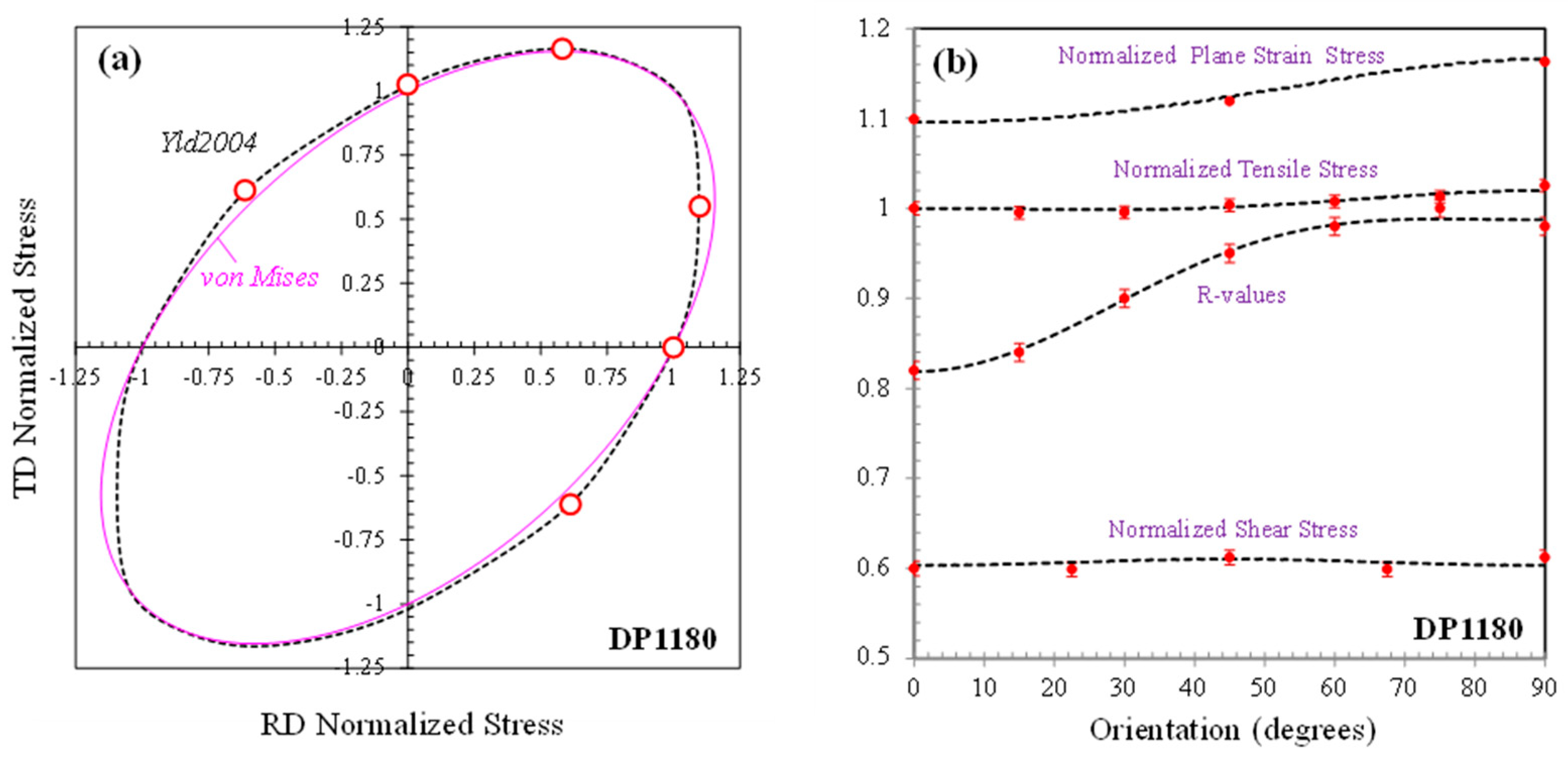
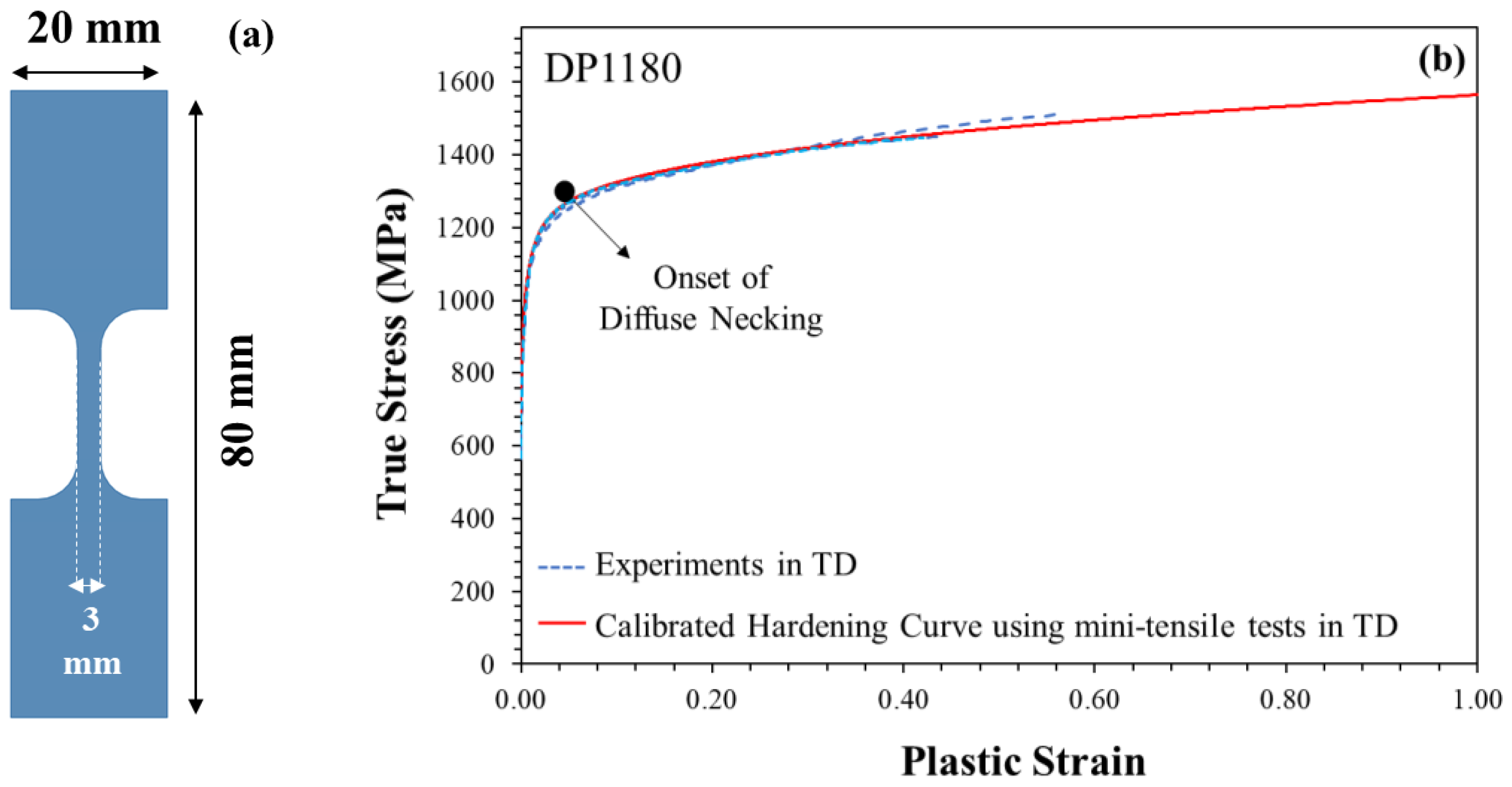
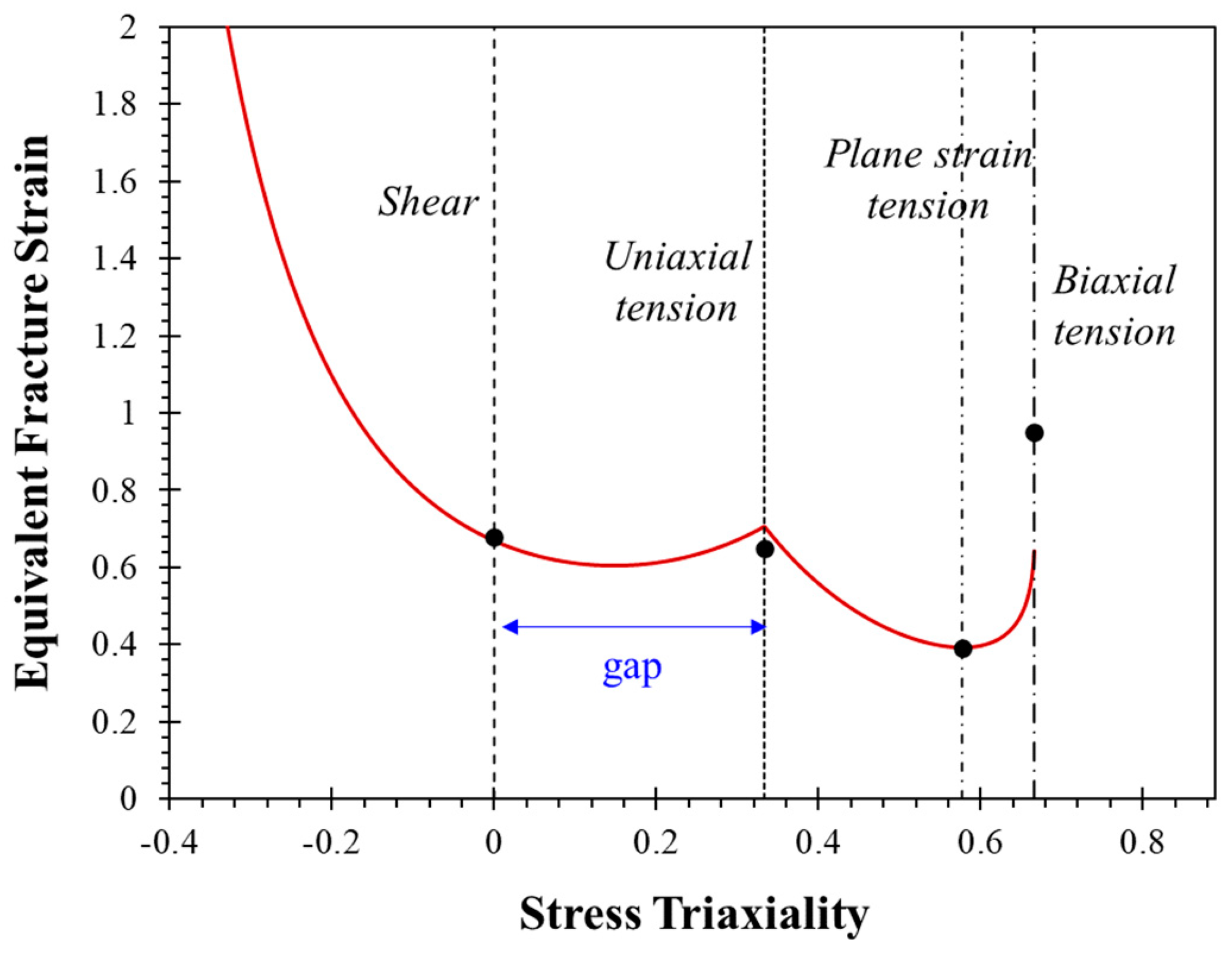
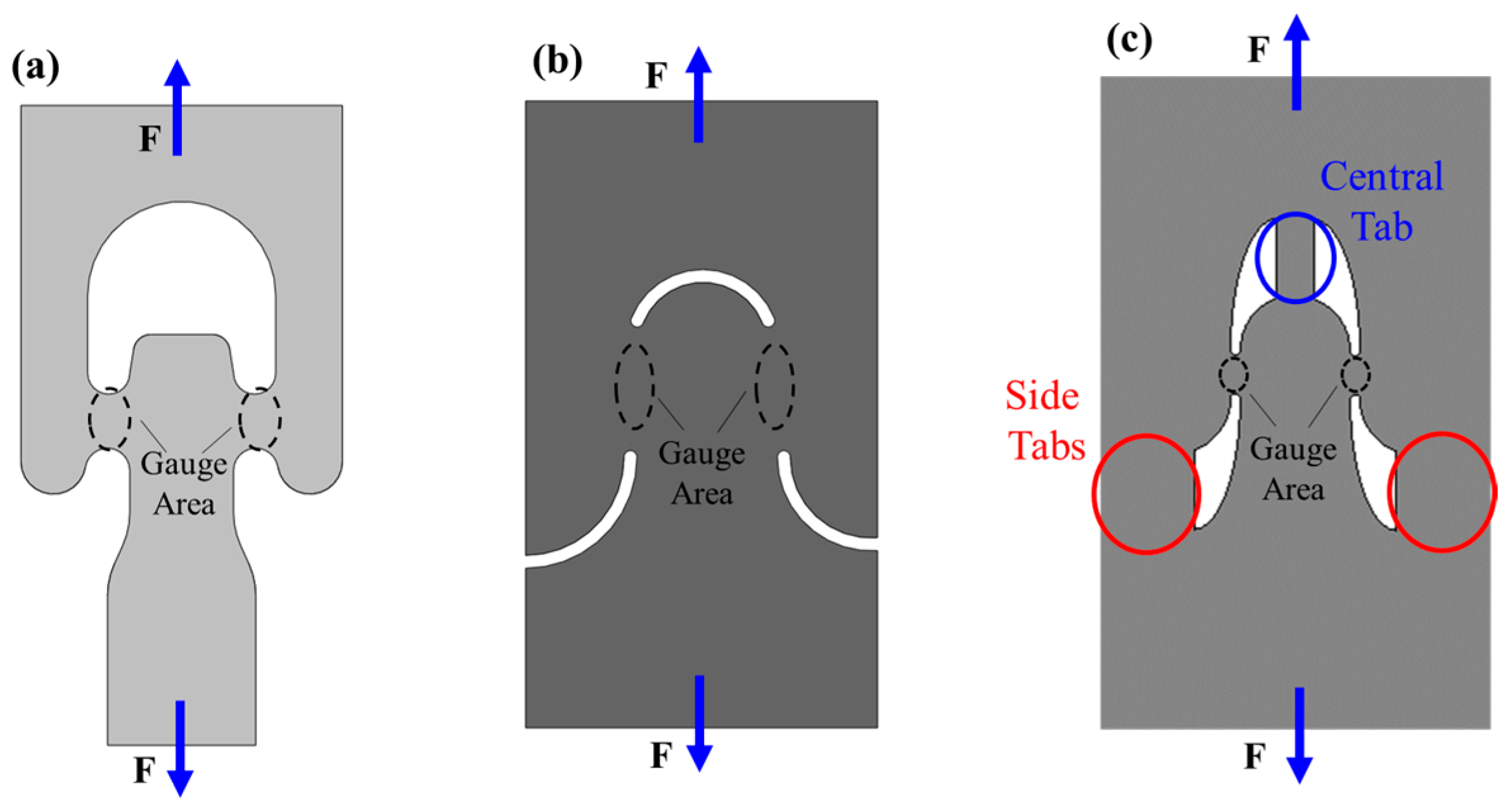
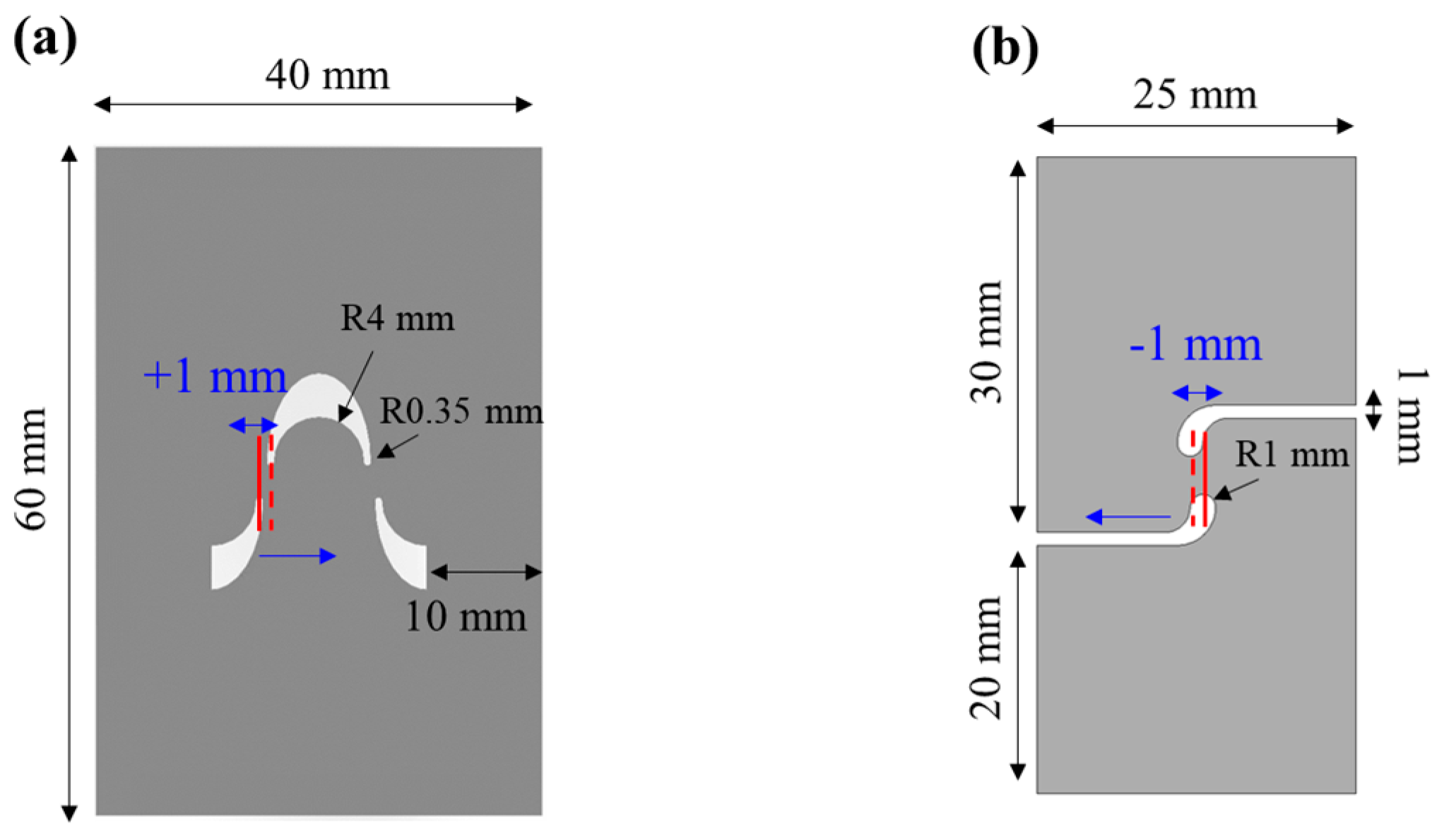
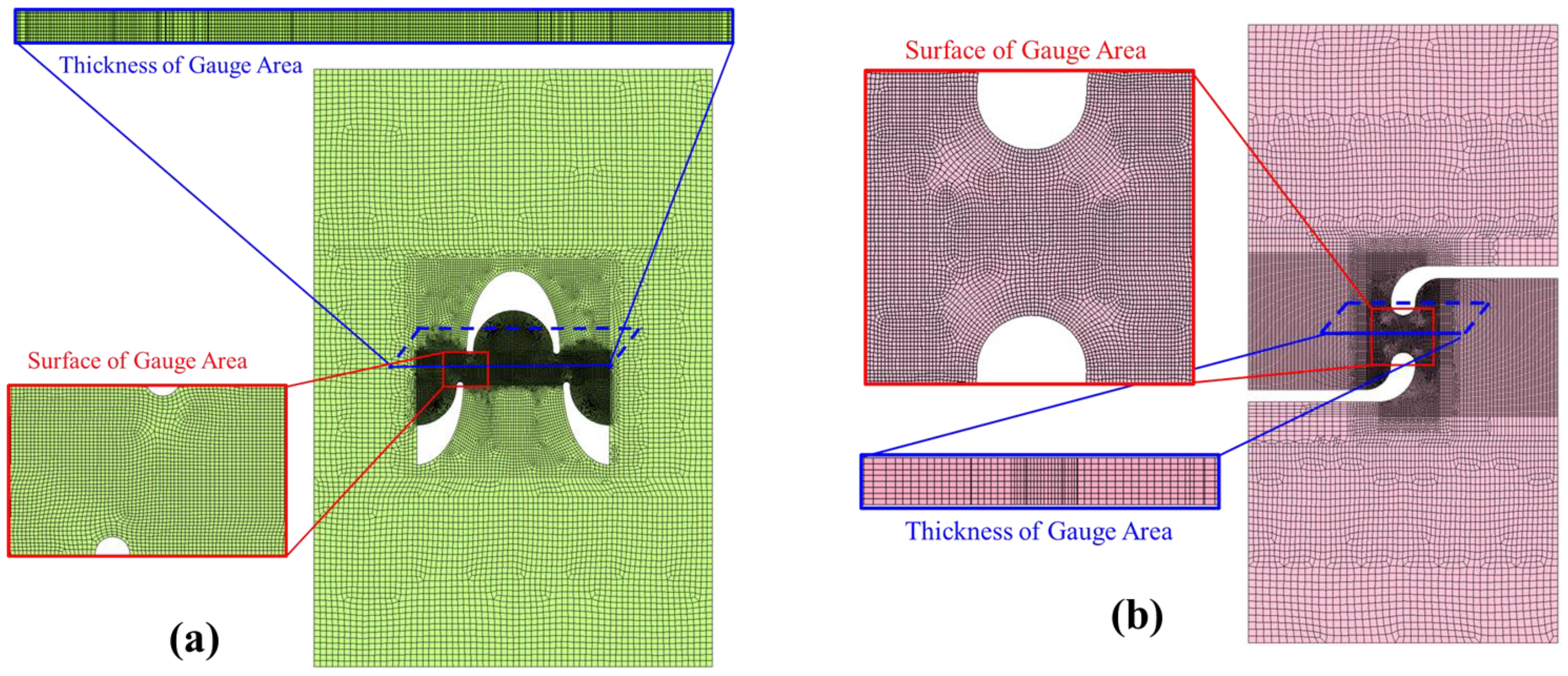
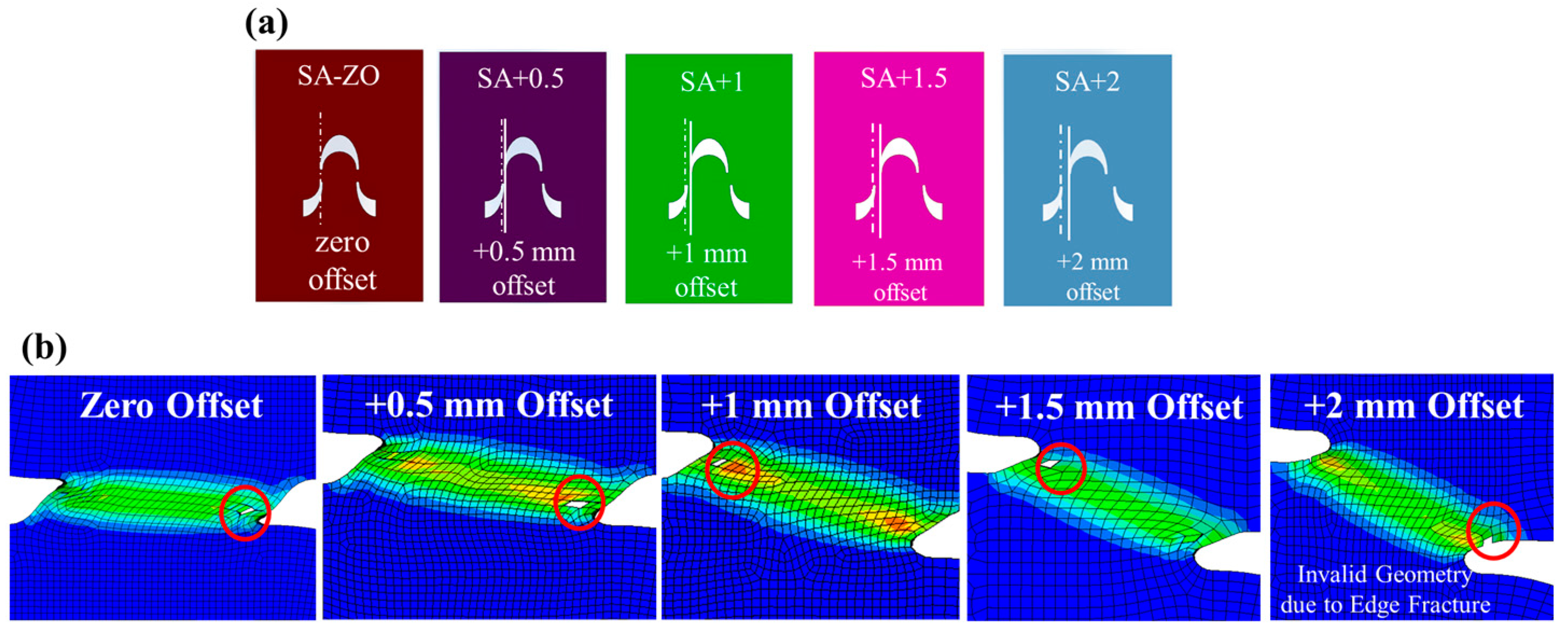
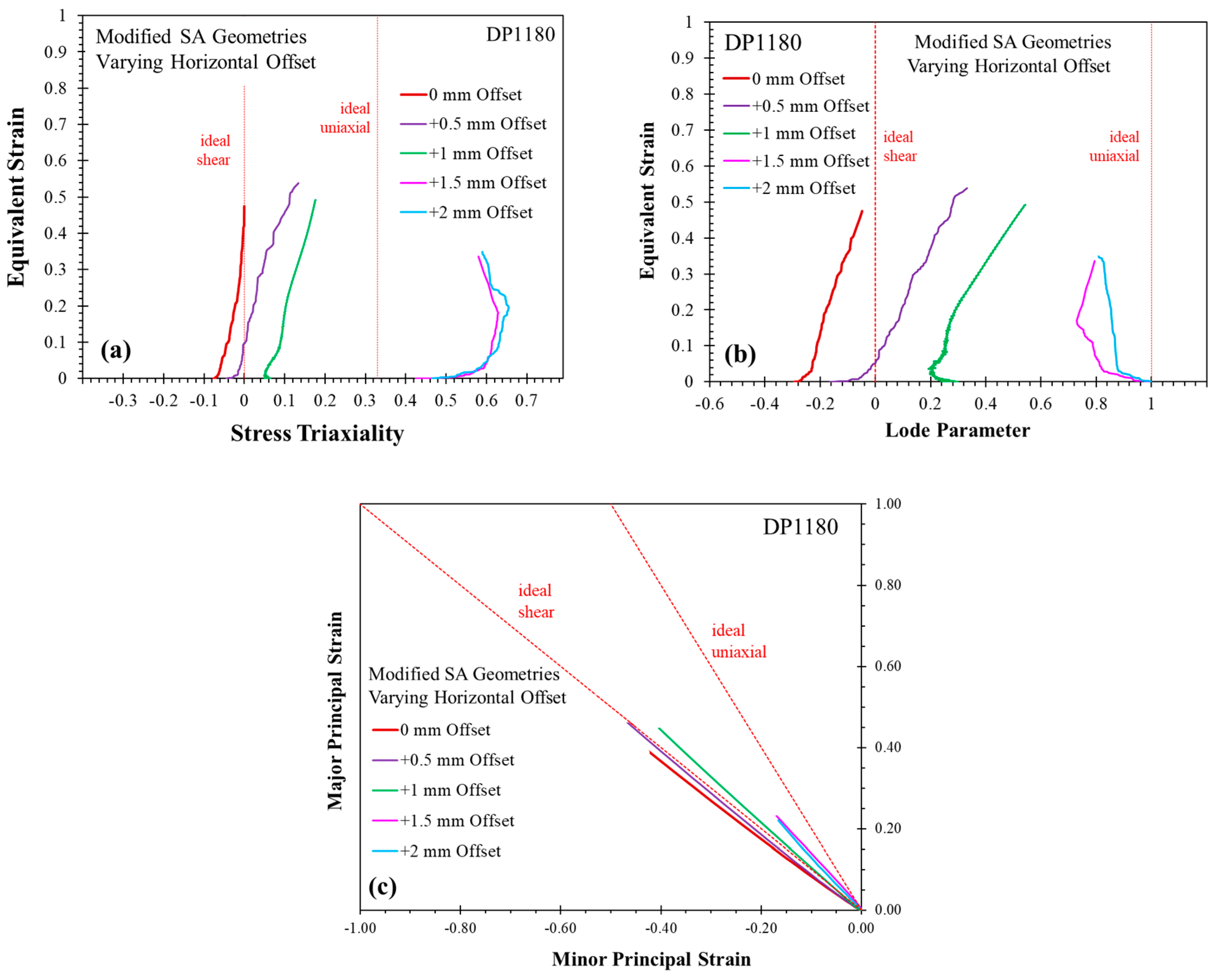
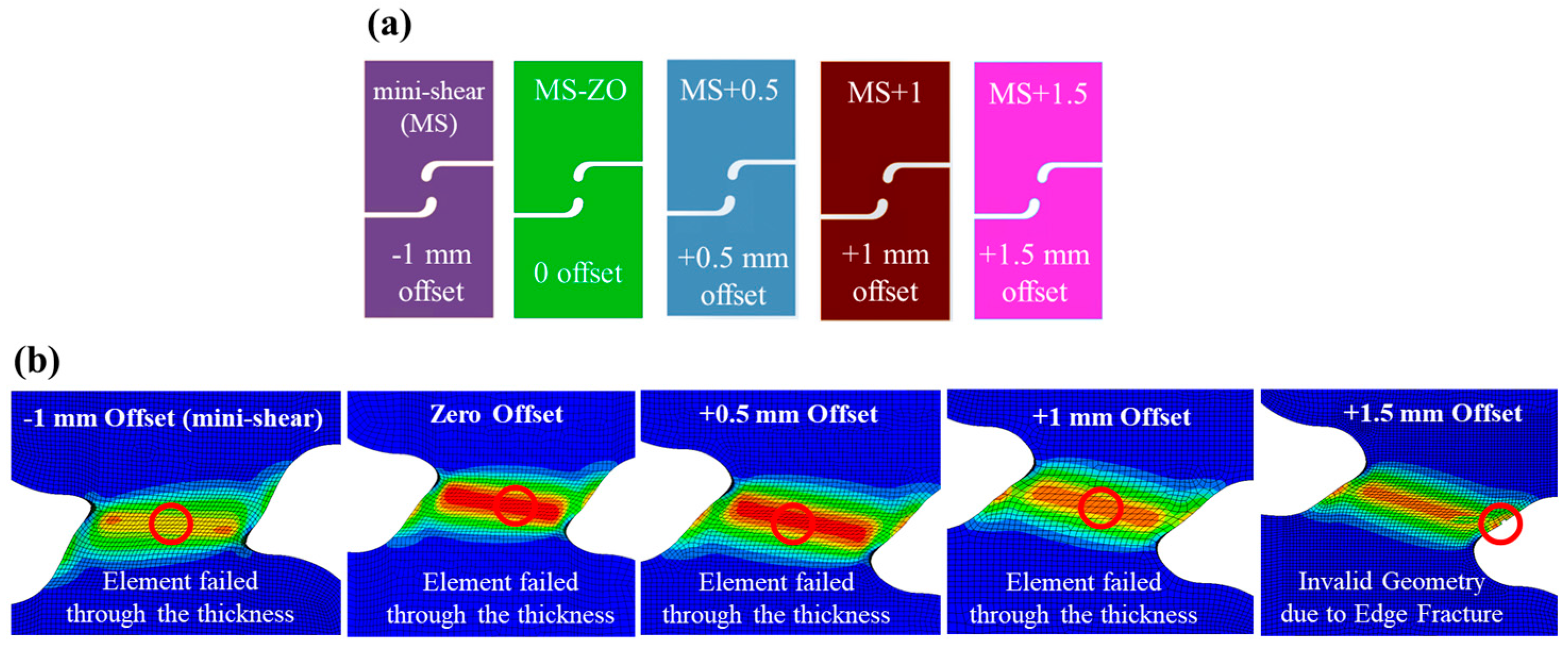
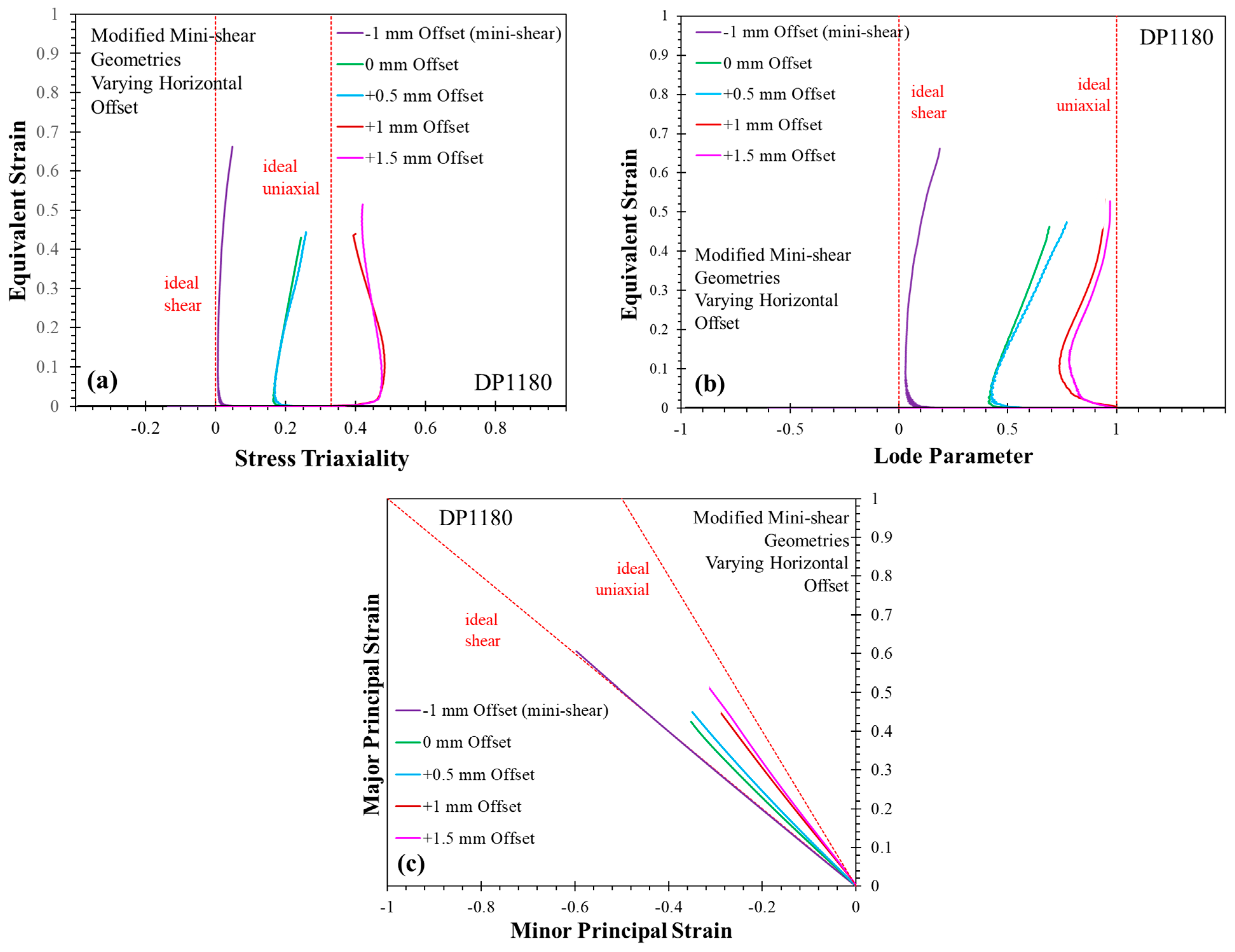

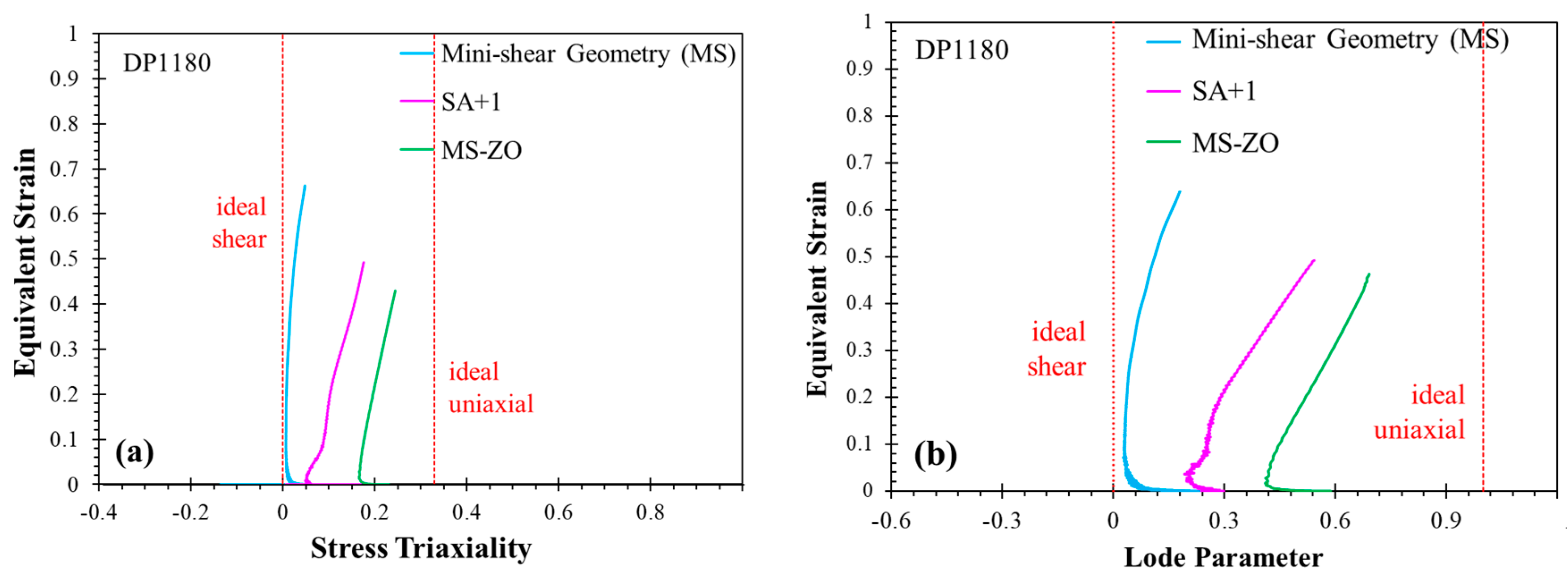
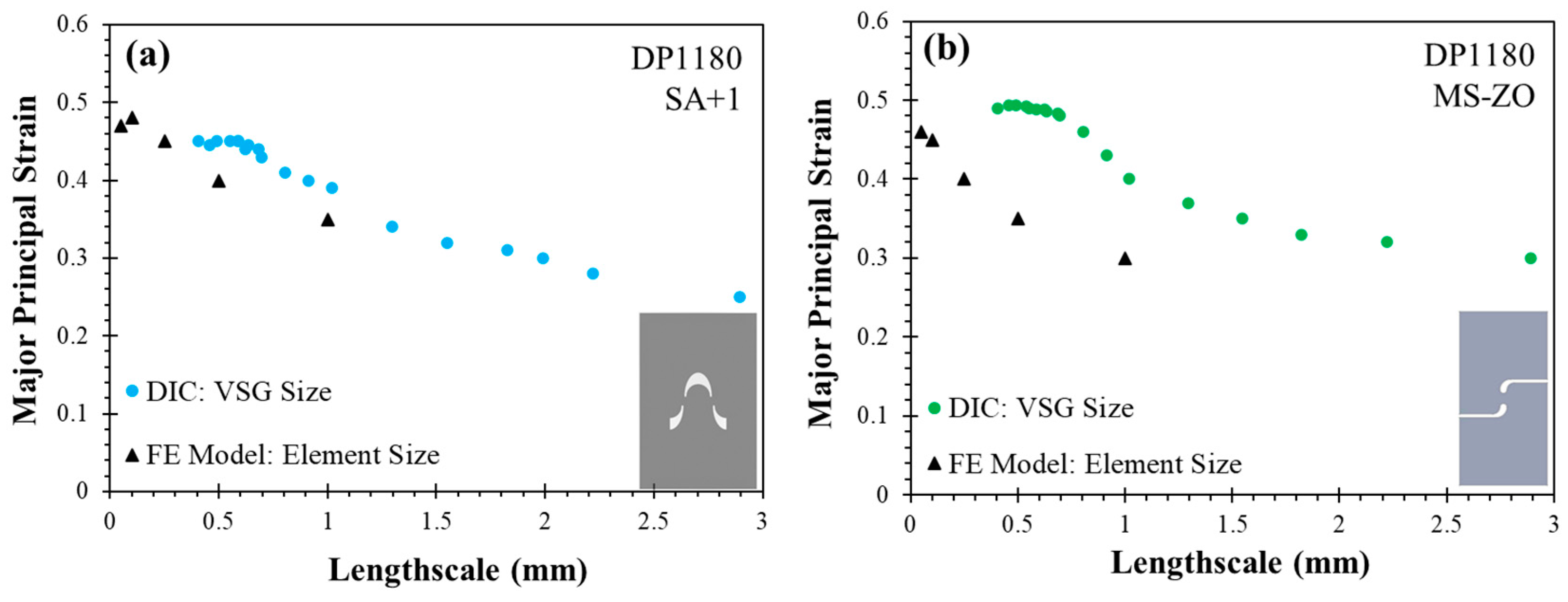
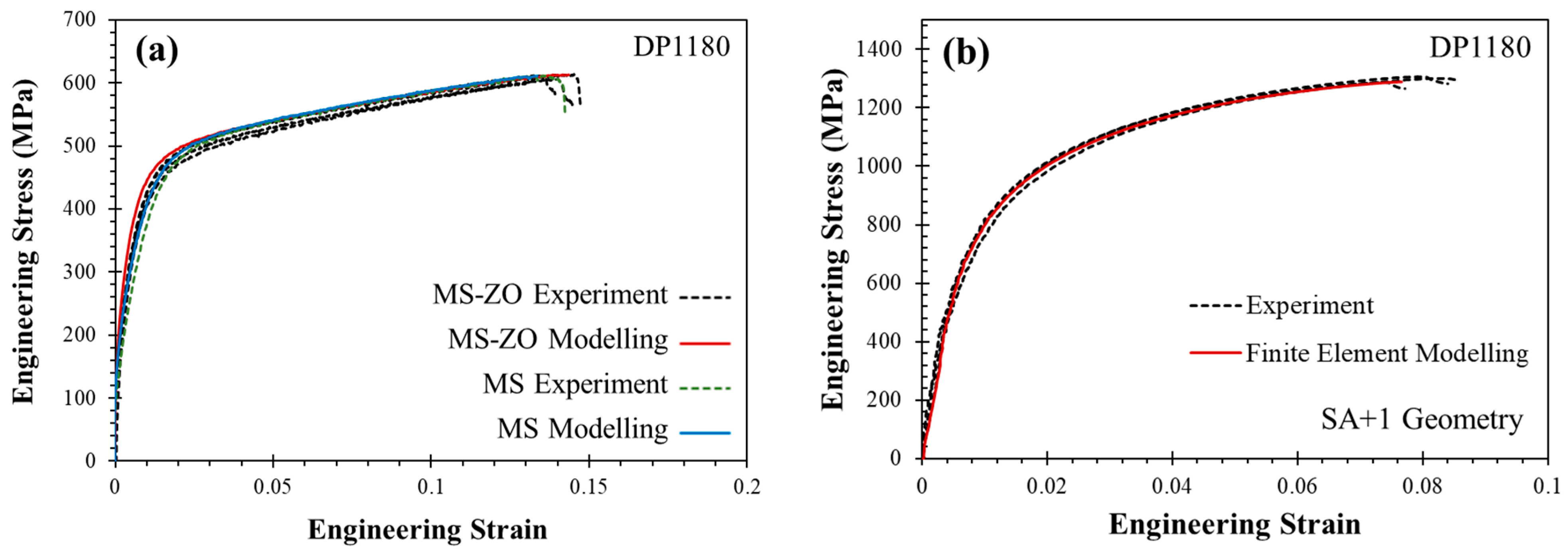
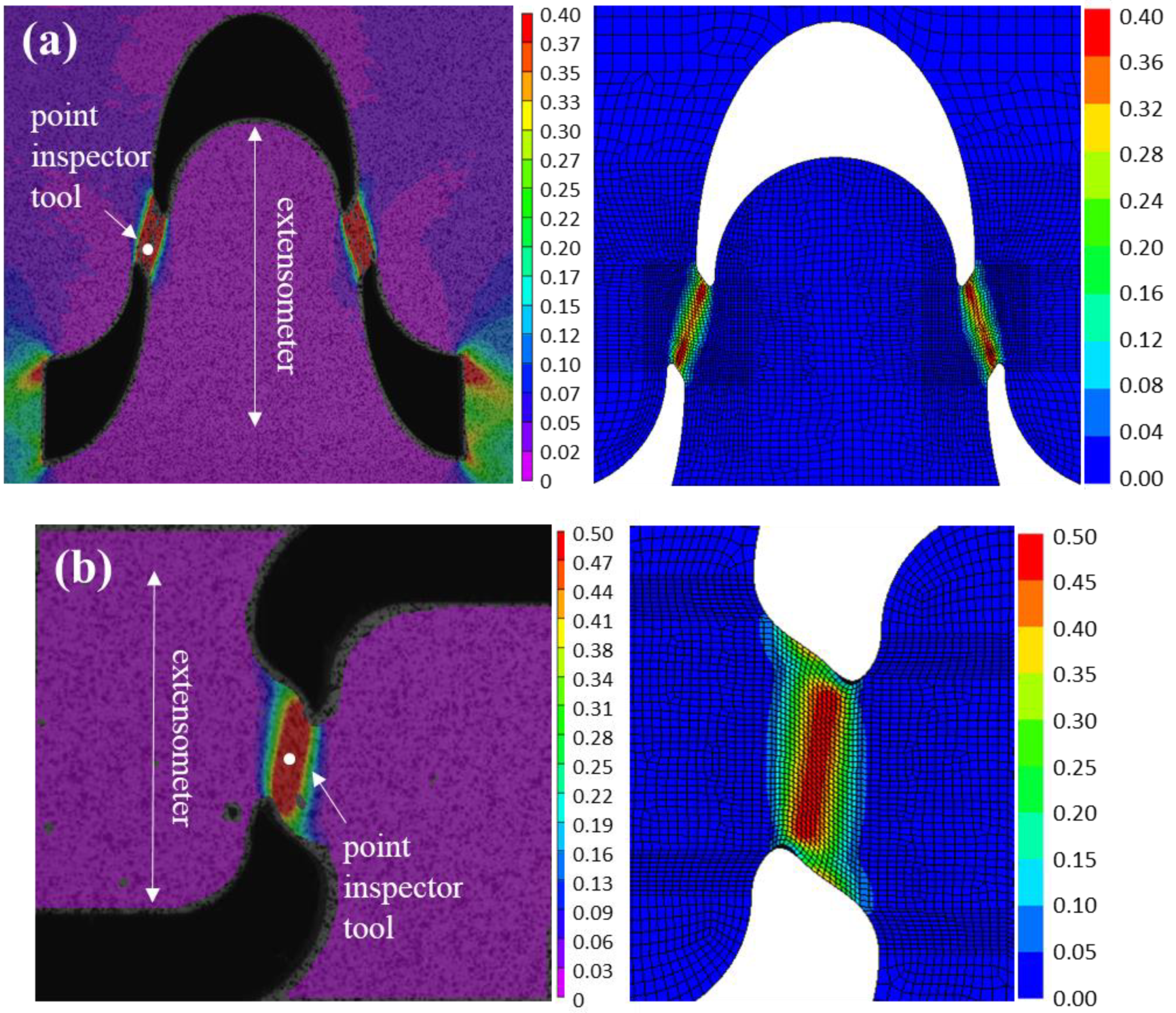

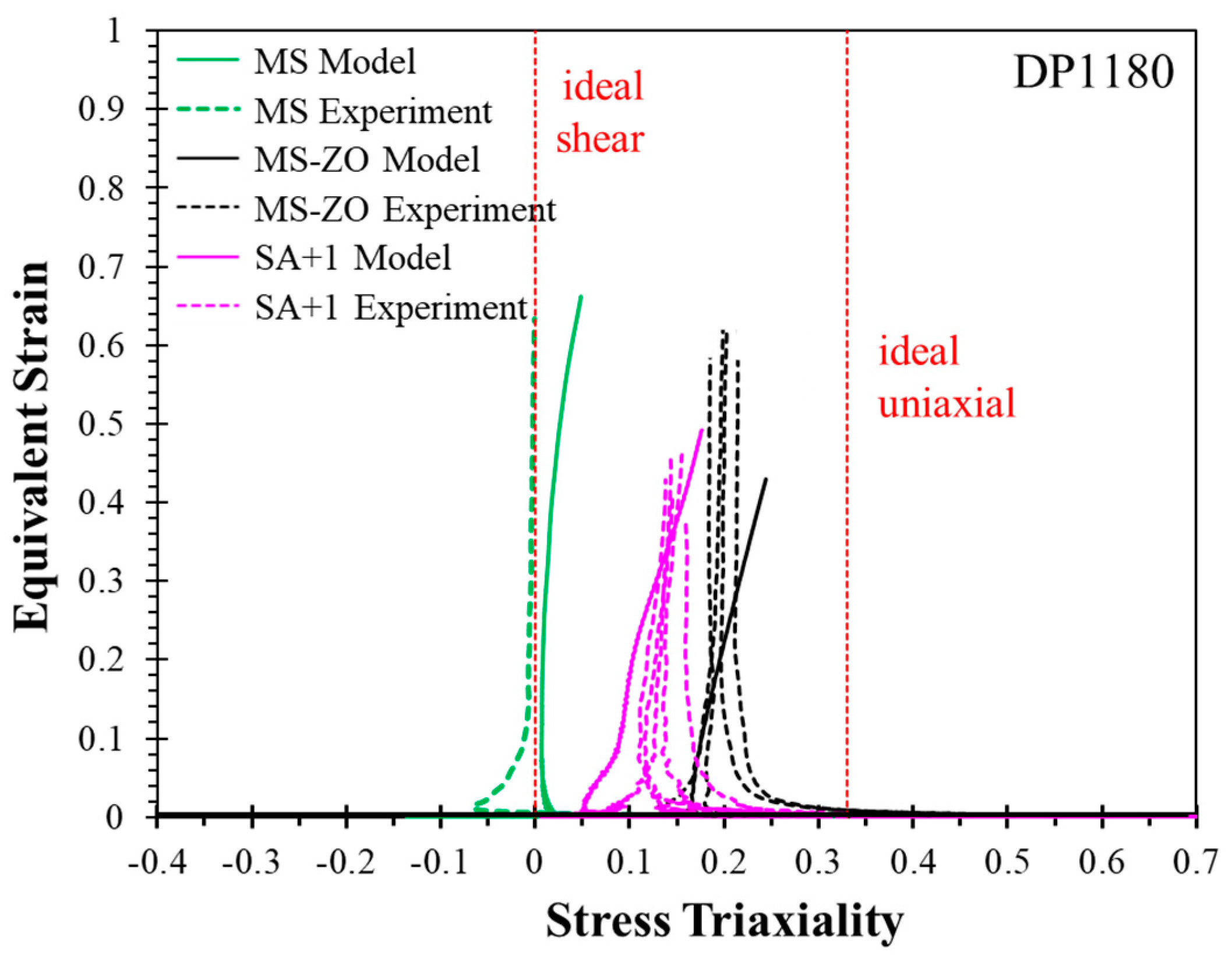
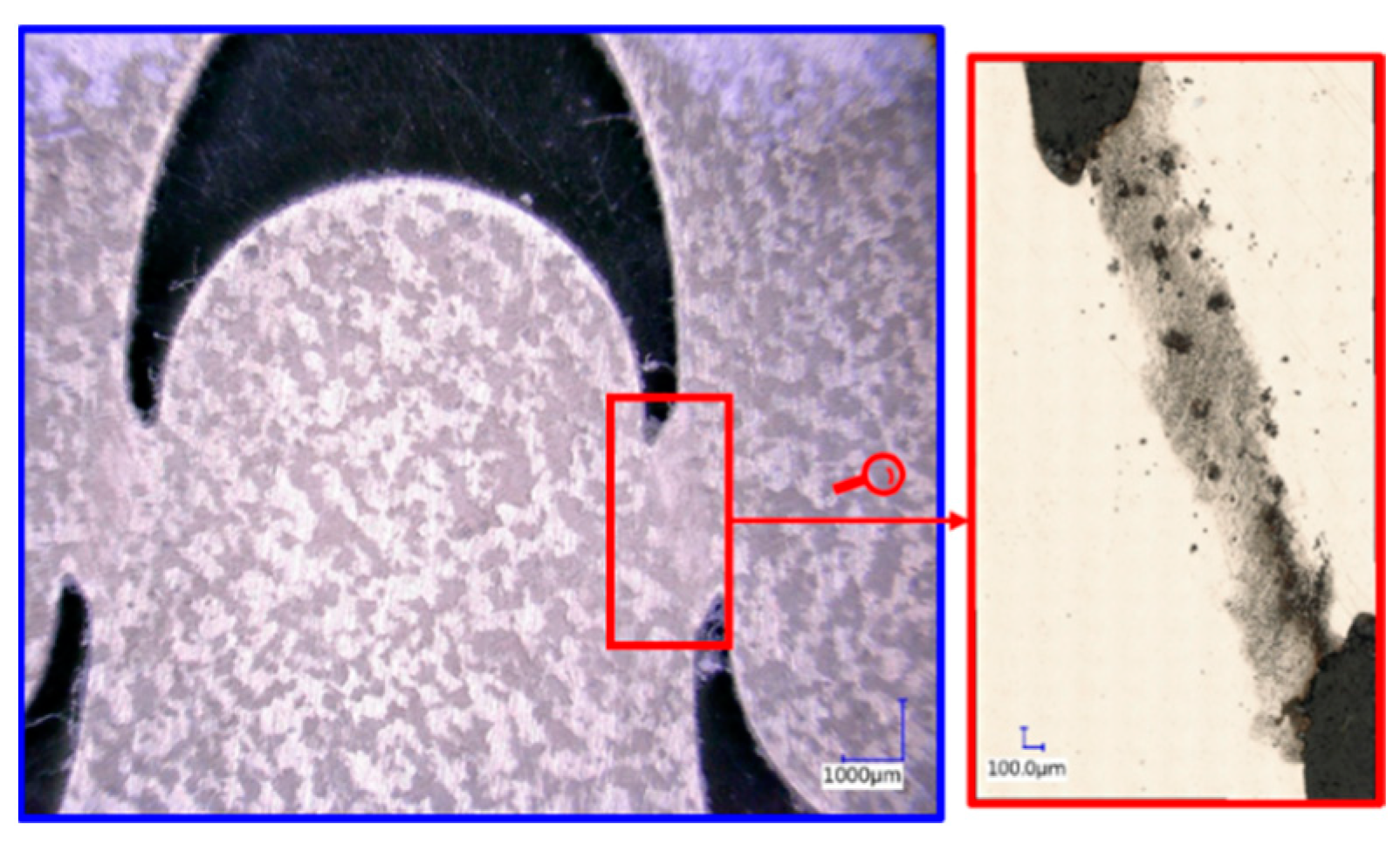

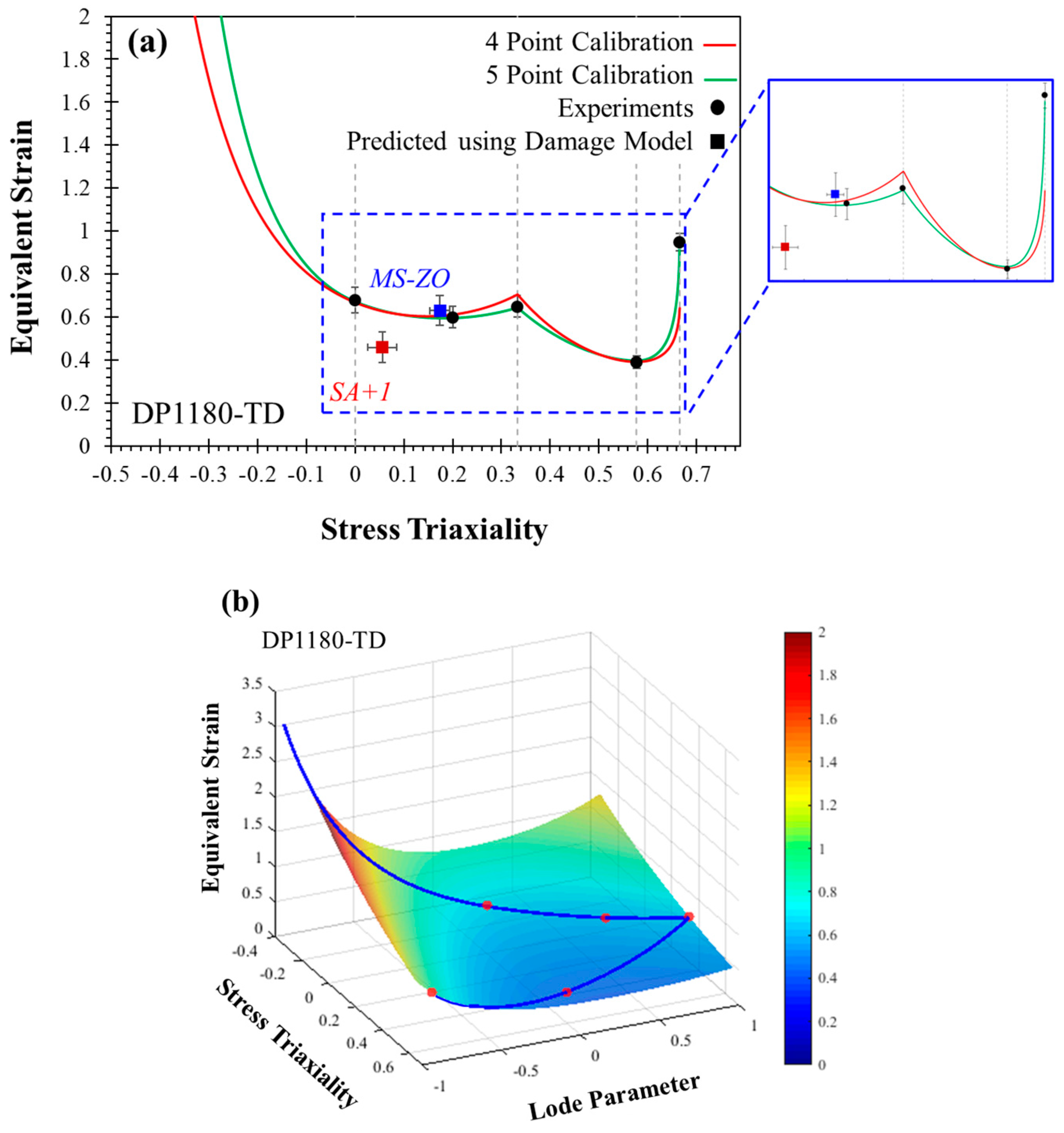
| Stress Ratio | R–Value | ||
|---|---|---|---|
| σ0/σ0 | 1.000 (0.006) | R0 | 0.82 (0.01) |
| σ15/σ0 | 0.995 (0.003) | R15 | 0.84 (0.01) |
| σ30/σ0 | 0.996 (0.003) | R30 | 0.90 (0.01) |
| σ45/σ0 | 1.004 (0.007) | R45 | 0.95 (0.01) |
| σ60/σ0 | 1.008 (0.008) | R60 | 0.98 (0.01) |
| σ75/σ0 | 1.013 (0.003) | R75 | 1.00 (0.00) |
| σ90/σ0 | 1.025 (0.007) | R90 | 0.98 (0.01) |
| τ0/σ0 | 0.600 (0.005) | Rb | 0.94 (0.03) |
| τ22.5/σ0 | 0.600 (0.008) | ||
| τ45/σ0 | 0.612 (0.005) | ||
| 1.099 (0.003) | |||
| 1.163 (0.004) | |||
| 1.119 (0.004) | |||
| 0.2654 | 0.4864 | 0.8357 | 0.8325 | 0.4413 | 0.1913 |
| 0.5622 | −0.5355 | −0.5355 | 0.8554 | 1.4708 | 1.4404 |
| 1.6083 | 1.3841 | 0.9212 | 1.1567 | 1.0000 | 1.0000 |
| (MPA) | (MPA) | (MPA) | (MPA) | |||
|---|---|---|---|---|---|---|
| 690 | 1233 | 17 | 0.58 | 293 | 0.458 | 30 |
| Loading Condition | Nominal Stress Triaxiality | Equation Strain at Fracture |
|---|---|---|
| Simple shear (Mini–shear test) | 0 | 0.68 (±0.05) |
| Uniaxial tension (Conical hole expansion test) | 0.333 | 0.65 (±0.04) |
| Plane strain tension (V–bend test) | 0.578 | 0.39 (±0.02) |
| Equi–biaxial stretching (Miniature dome test) | 0.666 | 0.95 (±0.03) |
| 0.0014 | 1.999 | 1 | 0.8674 | 0.0027 |
| Geometry | Average Stress Triaxiality | Equation Strain at Fracture |
|---|---|---|
| MS–ZO | 0.20 (±0.01) | 0.59 (±0.04) |
| SA + 1 | 0.15 (±0.03) | 0.51 (±0.06) |
| 0.0067 | 1.9976 | 0.9932 | 1 | 0.8714 | 0.0127 |
Disclaimer/Publisher’s Note: The statements, opinions and data contained in all publications are solely those of the individual author(s) and contributor(s) and not of MDPI and/or the editor(s). MDPI and/or the editor(s) disclaim responsibility for any injury to people or property resulting from any ideas, methods, instructions or products referred to in the content. |
© 2023 by the authors. Licensee MDPI, Basel, Switzerland. This article is an open access article distributed under the terms and conditions of the Creative Commons Attribution (CC BY) license (https://creativecommons.org/licenses/by/4.0/).
Share and Cite
Khameneh, F.; Abedini, A.; Butcher, C. Experimental and Numerical Fracture Characterization of DP1180 Steel in Combined Simple Shear and Uniaxial Tension. Metals 2023, 13, 1305. https://doi.org/10.3390/met13071305
Khameneh F, Abedini A, Butcher C. Experimental and Numerical Fracture Characterization of DP1180 Steel in Combined Simple Shear and Uniaxial Tension. Metals. 2023; 13(7):1305. https://doi.org/10.3390/met13071305
Chicago/Turabian StyleKhameneh, Farinaz, Armin Abedini, and Clifford Butcher. 2023. "Experimental and Numerical Fracture Characterization of DP1180 Steel in Combined Simple Shear and Uniaxial Tension" Metals 13, no. 7: 1305. https://doi.org/10.3390/met13071305
APA StyleKhameneh, F., Abedini, A., & Butcher, C. (2023). Experimental and Numerical Fracture Characterization of DP1180 Steel in Combined Simple Shear and Uniaxial Tension. Metals, 13(7), 1305. https://doi.org/10.3390/met13071305







